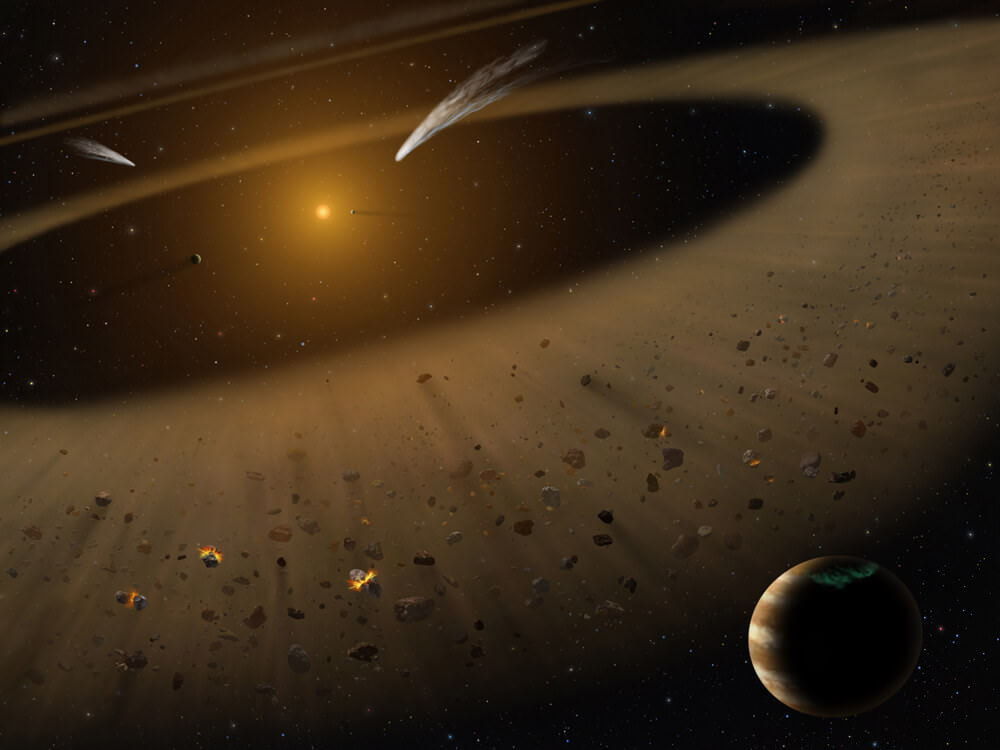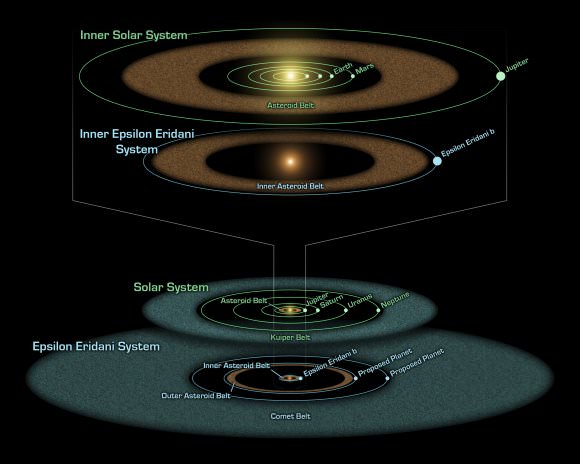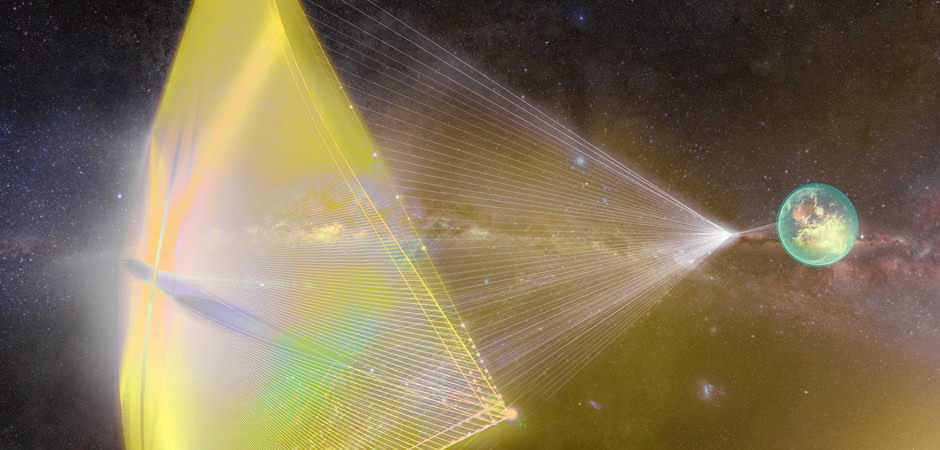Back in the year 2000, Epsilon Eridani b was discovered. It is a Jupiter-like exoplanet 10.5 light years away but it has taken decades of observations to learn more about the planet. One thing that remains a mystery is it’s orbit which, until recently has been unknown. There has never been a direct image of the planet either, so now, it’s the turn of JWST to see what it can do.
Continue reading “Astronomers Try to Directly Observe Epsilon Eridani b. No Luck. Maybe Webb Can Find it?”The Eridanus Constellation
Welcome to another edition of Constellation Friday! Today, in honor of the late and great Tammy Plotner, we take a look at the winding river – the Eridanus constellation. Enjoy!
In the 2nd century CE, Greek-Egyptian astronomer Claudius Ptolemaeus (aka. Ptolemy) compiled a list of the then-known 48 constellations. This treatise, known as the Almagest, would be used by medieval European and Islamic scholars for over a thousand years to come, effectively becoming astrological and astronomical canon until the early Modern Age.
One of these is the southern constellation of Eridanus, the sixth largest modern constellation in the night sky. The constellation takes its name from the Greek name for the river Po in Italy and is represented by a celestial river. This constellation is bordered by the constellations of Caelum, Cetus, Fornax, Horologium, Hydrus, Lepus, Phoenix, Taurus, and Tucana.
Only 10 Light-Years Away, there’s a Baby Version of the Solar System

Astronomers are understandanly fascinated with the Epsilon Eridani system. For one, this star system is in close proximity to our own, at a distance of about 10.5 light years from the Solar System. Second, it has been known for some time that it contains two asteroid belts and a large debris disk. And third, astronomers have suspected for many years that this star may also have a system of planets.
On top of all that, a new study by a team of astronomers has indicated that Epsilon Eridani may be what our own Solar System was like during its younger days. Relying on NASA’s Stratospheric Observatory for Infrared Astronomy (SOFIA) aircraft, the team conducted a detailed analysis of the system that showed how it has an architecture remarkably similar to what astronomer believe the Solar System once looked like.
Led by Kate Su – an Associate Astronomer with the Steward Observatory at the University of Arizona – the team includes researchers and astronomers from the Department of Physics & Astronomy of Iowa State University, the Astrophysical Institute and University Observatory at the University of Jena (Germany), and NASA’s Jet Propulsion Laboratory and Ames Research Center.

For the sake of their study – the results of which were published in The Astronomical Journal under the title “The Inner 25 AU Debris Distribution in the Epsilon Eri System” – the team relied on data obtained by a flight of SOFIA in January 2015. Combined with detailed computer modeling and research that went on for years, they were able to make new determinations about the structure of the debris disk.
As already noted, previous studies of Epsilon Eridani indicated that the system is surrounded by rings made up of materials that are basically leftovers from the process of planetary formation. Such rings consist of gas and dust, and are believed to contain many small rocky and icy bodies as well – like the Solar System’s own Kuiper Belt, which orbits our Sun beyond Neptune.
Careful measurements of the disk’s motion has also indicated that a planet with nearly the same mass as Jupiter circles the star at a distance comparable to Jupiter’s distance from the Sun. However, based on prior data obtained by the NASA’s Spitzer Space Telescope, scientists were unable to determine the position of warm material within the disk – i.e. the dust and gas – which gave rise to two models.
In one, warm material is concentrated into two narrow rings of debris that orbit the star at distances corresponding respectively to the Main Asteroid Belt and Uranus in our Solar System. According to this model, the largest planet in the system would likely be associated with an adjacent debris belt. In the other, warm material is in a broad disk, is not concentrated into asteroid belt-like rings, and is not associated with any planets in the inner region.

Using the new SOFIA images, Su and her team were able to determine that the warm material around Epsilon Eridani is arranged like the first model suggests. In essence, it is in at least one narrow belt, rather than in a broad continuous disk. As Su explained in a NASA press release:
“The high spatial resolution of SOFIA combined with the unique wavelength coverage and impressive dynamic range of the FORCAST camera allowed us to resolve the warm emission around eps Eri, confirming the model that located the warm material near the Jovian planet’s orbit. Furthermore, a planetary mass object is needed to stop the sheet of dust from the outer zone, similar to Neptune’s role in our solar system. It really is impressive how eps Eri, a much younger version of our solar system, is put together like ours.”
These observations were made possible thanks to SOFIA’s on-board telescopes, which have a greater diameter than Spitzer – 2.5 meters (100 inches) compared to Spitzer’s 0.85 m (33.5 inches). This allowed for far greater resolution, which the team used to discern details within the Epsilon Eridani system that were three times smaller than what had been observed using the Spitzer data.
In addition, the team made use of SOFIA’s powerful mid-infrared camera – the Faint Object infraRed CAmera for the SOFIA Telescope (FORCAST). This instrument allowed the team to study the strongest infrared emissions coming from the warm material around the star which are otherwise undetectable by ground-based observatories – at wavelengths between 25-40 microns.

These observations further indicate that the Epsilon Eridani system is much like our own, albeit in younger form. In addition to having asteroid belts and a debris disk that is similar to our Main Belt and Kuiper Belt, it appears that it likely has more planets waiting to be found within the spaces between. As such, the study of this system could help astronomers to learn things about the history of our own Solar System.
Massimo Marengo, one of he co-authors of the study, is an Associate Professor with the Department of Physics & Astronomy at Iowa State University. As he explained in a University of Iowa press release:
“This star hosts a planetary system currently undergoing the same cataclysmic processes that happened to the solar system in its youth, at the time in which the moon gained most of its craters, Earth acquired the water in its oceans, and the conditions favorable for life on our planet were set.”
At the moment, more studies will need to be conducted on this neighboring stars system in order to learn more about its structure and confirm the existence of more planets. And it is expected that the deployment of next-generation instruments – like the James Webb Space Telescope, scheduled for launch in October of 2018 – will be extremely helpful in that regard.
“The prize at the end of this road is to understand the true structure of Epsilon Eridani’s out-of-this-world disk, and its interactions with the cohort of planets likely inhabiting its system,” Marengo wrote in a newsletter about the project. “SOFIA, by its unique ability of capturing infrared light in the dry stratospheric sky, is the closest we have to a time machine, revealing a glimpse of Earth’s ancient past by observing the present of a nearby young sun.”
Further Reading: NASA, IAState, The Astronomical Journal
What is the Smallest Star?
We’ve talked about the biggest stars, but what about the smallest stars? What’s the smallest star you can see with your own eyes, and how small can they get?
Space and astronomy is always flaunting its size issues. Biggest star, hugest nebula, prettiest most talented massive galaxy, most infinite universe, and which comet came out on top in the bikini category. Blah blah blah.
In an effort to balance the scales a little we’re going look at the other end of the spectrum. Today we’re talking small stars. First, I’m going to get the Gary Coleman and Emmanuel Lewis joke out of the way, so we can start talking about adorable little teeny tiny fusion factories.
We get big stars when we’ve got many times the mass of the Sun’s worth of hydrogen in one spot. Unsurprisingly, to get smaller stars we’ll need less hydrogen, but there’s a line we can’t cross where there’s so little, that it won’t generate the temperature and pressure at its core to ignite solar fusion. Then it’s a blob, it’s a mess. It’s clean-up in aisle Andromeda. It’s who didn’t put the lid back on the jar marked H.
So how small can stars get? And what’s the smallest star we know about? In the traditional sense, a star is an object that has enough mass and pressure in its core that it can ignite fusion, crushing atoms of hydrogen into helium.
Fusion is exothermic, releasing energy. It’s this energy that counteracts the force of gravity pulling everything inward. That gives you the size of the star and keeps it from collapsing in on itself.
By some random coincidence and fluke of nature our Sun is exactly 1 solar mass. Actually, that’s not true at all, our shame is that we use our Sun as the measuring stick for other stars. This might be the root of this size business. We’re in an endless star measuring contest, with whose is the most massive and whose has the largest circumference?
So, as it turns out, you can still have fusion reactions within a star if you get all the way down to 7.5% of a solar mass. This is the version you know as a red dwarf. We haven’t had a chance to measure many red dwarf stars, but the nearest star, Proxima Centauri, has about 12.3% the mass of the Sun and measures only 200,000 kilometers across. In other words, the smallest possible red dwarf would only be about 50% larger than Jupiter.
There is an important distinction, this red dwarf star would have about EIGHTY times the mass of Jupiter. I know that sounds crazy, but when you pile on more hydrogen, it doesn’t make the star that much bigger. It only makes it denser as the gravity pulls the star together more and more.
At the time I’m recording this video, this is smallest known star at 9% the mass of the Sun, just a smidge over the smallest theoretical size.

Proxima Centauri is about 12% of a solar mass, and the closest star to Earth, after the Sun. But it’s much too dim to be seen without a telescope. In fact, no red dwarfs are visible with the unaided eye. The smallest star you can see is 61 Cygni, a binary pair with one star getting only 66% the size of the Sun. It’s only 11.4 light years away, and you can just barely see it in dark skies. After that it’s Spock’s home, Epsilon Eridani, with 74% the size of the Sun, then Alpha Centauri B with 87%, and then the Sun. So, here’s your new nerd party fact. The Sun is the 4th smallest star you can see with your own eyes. All the other stars you can see are much bigger than the Sun. They’re all gigantic terrifying monsters.
And in the end, our Sun is absolutely huge compared to the smallest stars out there. We here like to think of our Sun as perfectly adequate for our needs, it’s ours and all life on Earth is there because of it. It’s exactly the right size for us. So don’t you worry for one second about all those other big stars out there.
And if you like what you see, come check out our Patreon page and find out how you can get these videos early while helping us bring you more great content!




